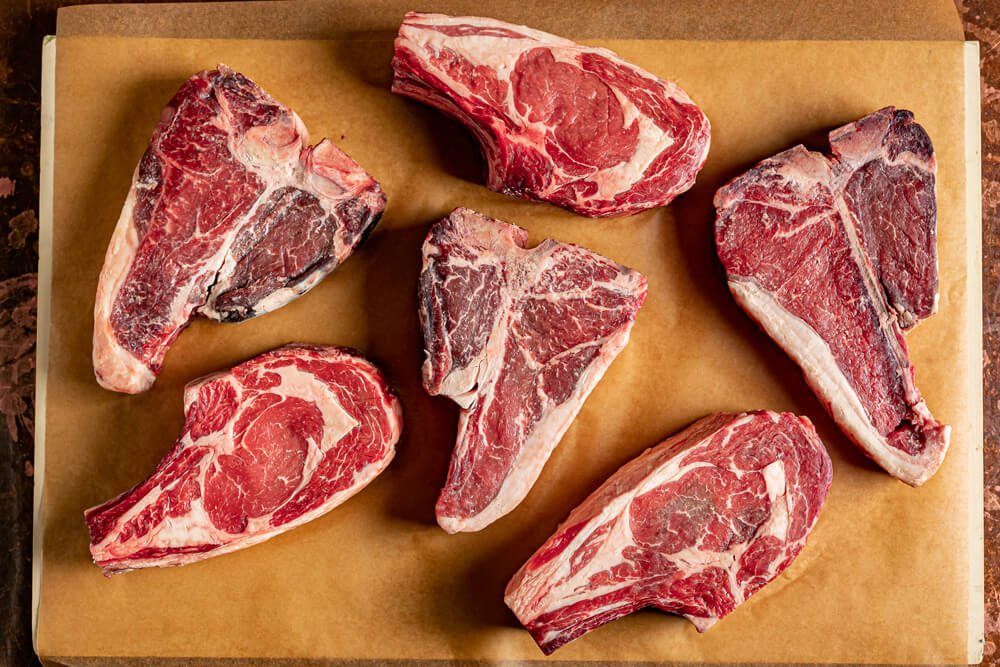
How To Cook The Perfect Steak
If you don’t happen to have a charcoal grill, a Josper, or a Thermodyne in your apartment, fear not, you can still cook a great steak.
1. Buy Good Meat
This is the key. But it can be easier said than done – our advice is to find a good butcher and ask lots of questions. Here’s our checklist:
- Is the beef is locally-sourced?
- Is the beef grass-fed?
- Did the beef come from a cow that was slaughtered at more than thirty months old?
- Has it been dry-aged for at least twenty-eight days?
2. Buy Big
The aim is to get a good char on the outside while keeping the meat juicy and tender inside; this is very difficult with a thin piece of meat. Ideally, each steak should be at least 10oz, and 1.5in thick. But, you can always buy bigger and share a steak with a couple of people.
3. Take the Meat Out of the Fridge
It needs at least an hour before you cook it, to bring it up to room temperature.
4. Fire Up the Cast-iron Pan (or, if You’re One of the Lucky Ones, a BBQ)
Get that cast iron griddle smoking hot. If you’re using a barbecue we’d recommend lump wood charcoal from sustainable sources, and make sure you use eco-friendly, non-impregnated firelighters to avoid any fuel tainting the favor of the meat. There are three ingredients needed for a perfect steak: beef, charcoal, and salt. Getting all three right is crucial – there’s no point in buying a beautiful piece of beef and using lighter-fuel impregnated briquettes.
5. Get the Pan or BBQ Really, Really Hot
The grill pan needs 5 minutes over high heat. If you’re using a barbecue you’re looking for white-hot coals, which will take about an hour from lighting. It should be painful to hold your hand anywhere near the heat source. If you’re inside, open the window – there will be LOTS of smoke.
6. If Your Steak Is Wet, Dry It With Paper Towel
Otherwise, it will struggle to form a decent crust and can pick up some unpleasant boiled-meat flavors. At the last minute, season the meat well with Maldon sea salt. You will need to use more than you probably think is sensible, but, we promise it will help build a delicious salty crust.
7. Don’t Use Any Oil On the Meat or In The Pan
If the grill is hot enough the meat won’t stick. As well as being unnecessary, oil tends to add a hint of flavor that doesn’t sit well with good beef. If you’re really worried, you can cut a small piece of fat off your steak (or ask your butcher for a piece) and rub it over the grill with a pair of tongs.
8. Stick the Steak on
Leave it for a couple of moments to start building up a crust, then flip. Carry on turning every couple of minutes until it’s the way you like it, and don’t forget to sear the edges. If the heat is as fierce as our charcoal grill at Hawksmoor you may need to move it more regularly to avoid burning – our grill chefs say every 5 seconds. If cooking multiple steaks, don’t overcrowd the grill or pan – make sure there’s plenty of space between each steak.
If there is a thick layer of fat on your steak, hold it up vertically with long tongs to brown the fat.
9. Check if Your Steak Is Cooked
You can use touch, which our grill chefs do, or you can use a probe, which our grill chefs also do to make sure every steak is perfect. Cooking temperatures are subjective and perceptions even vary from country to country. The internal temperature should be at the bottom end of each range at the end of cooking and towards the top end once rested. (Medium rare 131°F-140°F, Medium 140°F to 149°F, Medium Well 149°F-158°F)
10. Rest Your Meat
In the restaurant, we rest meat at 132.8 °F but at home that’s going to be tricky… 5 minutes for a single steak or 10-15 minutes for a large sharing steak on a warm plate should do it. Serve on hot plates.
11. Crack Open a Bottle of Good Wine
Eat, drink & be merry!
